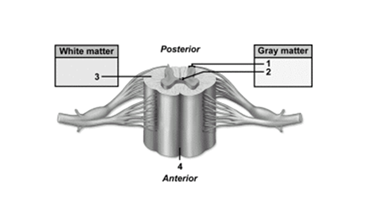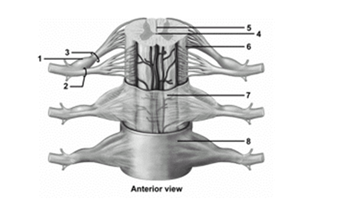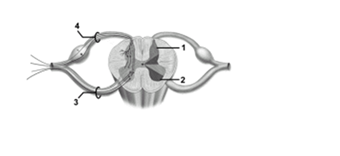A) helps to overcome pain.
B) aids in sending sensory information to the muscles.
C) prevents skeletal muscles from tensing excessively.
D) prevents muscles from contracting.
E) helps to gain balance through a complex series of muscular contractions.
Correct Answer

verified
Correct Answer
verified
True/False
The obturator nerve innervates muscles of the lateral thigh.
Correct Answer

verified
Correct Answer
verified
Multiple Choice
The posterior horns of the spinal cord contain
A) axons of motor neurons and cell bodies of interneurons.
B) axons of sensory and motor neurons.
C) axons of interneurons.
D) axons of sensory neurons and cell bodies of interneurons.
E) autonomic motor neurons.
Correct Answer

verified
Correct Answer
verified
True/False
Neurons in the primary somatosensory cortex receive input from tertiary neurons that have their cell bodies residing in the thalamus.
Correct Answer

verified
Correct Answer
verified
Short Answer
A specific segment of skin supplied by a single spinal nerve is a ___________.
Correct Answer

verified
Correct Answer
verified
Short Answer
Paired,lateral triangular extensions of the spinal pia mater that extend to the dura to suspend and anchor the spinal cord are known as _________ ligaments.
Correct Answer

verified
Correct Answer
verified
Multiple Choice
The largest and longest nerve in the body is the _________ nerve.
A) femoral
B) radial
C) sciatic
D) obturator
E) saphenous
Correct Answer

verified
Correct Answer
verified
True/False
The spinocerebellar pathway is an ascending somatosensory pathway.
Correct Answer

verified
Correct Answer
verified
Multiple Choice
What is the thin strand of pia mater that helps to anchor the spinal cord to the coccyx
A) Conus medullaris
B) Cervical enlargement
C) Terminus coccyx
D) Filum terminale
E) Coccygeal tendon
Correct Answer

verified
Correct Answer
verified
Multiple Choice
A typical spinal cord in an adult is
A) 24-26 inches long.
B) 12-14 inches long.
C) 8-10 inches long.
D) 16-18 inches long.
E) 20-24 inches long.
Correct Answer

verified
Correct Answer
verified
Multiple Choice
Following an injury to his arm,a patient complains that he has lost the ability to flex his elbow and supinate his forearm.Which nerve do you suspect he has damaged
A) Median nerve
B) Radial nerve
C) Musculocutaneous nerve
D) Ulnar nerve
E) Axillary nerve
Correct Answer

verified
Correct Answer
verified
Multiple Choice
 -This figure shows a cross section of the spinal cord.What structure does number 4 indicate
-This figure shows a cross section of the spinal cord.What structure does number 4 indicate
A) Posterior median sulcus
B) White commissure
C) Anterior funiculus
D) Lateral funiculus
E) Anterior median fissure
Correct Answer

verified
Correct Answer
verified
Multiple Choice
For many reflexes,including the stretch reflex,the excitation of a muscle leads to
A) excitation of all motorneurons that are contralateral.
B) inhibition of motor neurons of its antagonist.
C) inhibition of motor neurons of its synergist.
D) excitation of motor neurons of the antagonist.
E) inhibition of sensory neurons that initiate the reflex.
Correct Answer

verified
Correct Answer
verified
Multiple Choice
Two of the nerves of the lumbar plexus are the
A) femoral and sciatic nerves.
B) femoral and obturator nerves.
C) obturator and pudendal nerves.
D) pudendal and sciatic nerves.
Correct Answer

verified
Correct Answer
verified
Multiple Choice
 -This figure shows an anterior view of the spinal cord and meninges.What structure does number 7 indicate
-This figure shows an anterior view of the spinal cord and meninges.What structure does number 7 indicate
A) Arachnoid
B) Pia mater
C) Dura mater
D) Gray matter
E) White matter
Correct Answer

verified
Correct Answer
verified
Multiple Choice
 -This figure shows neuron pathways and nuclei locations.What type of nuclei does number 1 indicate
-This figure shows neuron pathways and nuclei locations.What type of nuclei does number 1 indicate
A) Somatic motor nuclei
B) Autonomic motor nuclei
C) Visceral sensory nuclei
D) Somatic sensory nuclei
E) None of the choices is correct
Correct Answer

verified
Correct Answer
verified
Multiple Choice
 -This figure shows a cross section of the spinal cord.What structure does number 3 indicate
-This figure shows a cross section of the spinal cord.What structure does number 3 indicate
A) Posterior funiculus
B) White commissure
C) Anterior funiculus
D) Lateral funiculus
E) Anterior median fissure
Correct Answer

verified
Correct Answer
verified
Multiple Choice
Within the axilla,axons of neurons are organized within
A) three cords-the posterior,medial,and lateral cords.
B) three divisions-the superior,middle,and inferior divisions.
C) five cords-the superior,inferior,medial,lateral,and middle divisions.
D) five divisions-proximal,distal,ulnar,median,and radial divisions.
Correct Answer

verified
Correct Answer
verified
Multiple Choice
Which accurately describes sensory and motor pathways
A) Sensory pathways terminate in the brain,and motor pathways terminate at effectors.
B) Both sensory and motor pathways terminate in the brain.
C) Both sensory and motor pathways terminate in the PNS.
D) Sensory pathways terminate at effectors and motor pathways terminate in the brain.
Correct Answer

verified
Correct Answer
verified
Multiple Choice
Which are not spinal nerve branches
A) Rami communicantes
B) Posterior rami
C) Anterior rami
D) Lateral rami
Correct Answer

verified
Correct Answer
verified
Showing 81 - 100 of 130
Related Exams